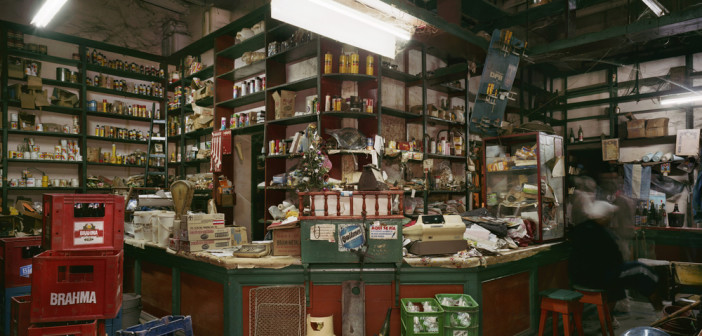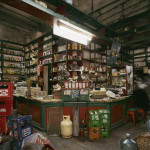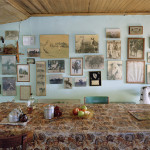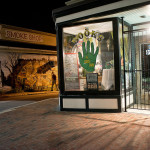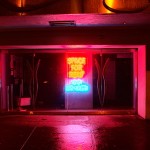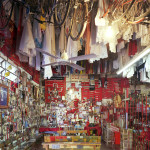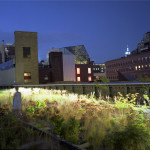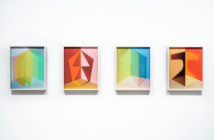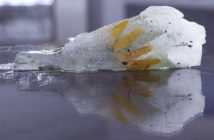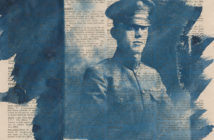The decision to pair Guillermo Srodek-Hart’s Interiors with Lynn Saville’s Vacancy is so compelling that I expected it to have been a curatorial strategy as carefully crafted as military tactics. But longtime gallery director and owner Arlette Kayafas knows the intricacies of her artists’ work so well, that the only strategy she needs is pure intuition. Now on view at Gallery Kayafas, the joint exhibition ofInteriors and Vacancy is a sustained exercise in dichotomies: of presence and absence, interiors and exteriors, industry and abandonment, disarray and order. But it goes one (necessary, I believe) step further, complicating these easy exclusions. In the 28 photographs on display, exteriors overlap with interiors in reflections, clutter is strangely ordered, and intimate views of workshops evidence all the bustle of human activity, but are empty. I asked about the intention behind the juxtaposition of these two seemingly very different bodies of work; Arlette did not have any marching orders in mind for the exhibition, but noted instead her natural tendency to pair the photographs of Srodek-Hart and Saville. In 2009, she realized, she had exhibited their work together for the first time.
The dialogue between Srodek-Hart’s interior spaces and Saville’s exterior places is theoretically rich enough to sustain our attention this second time around. Working just outside of Buenos Aires, Srodek-Hart photographs dwellings, butcher shops, bars and dry cleaners, and all manner of workshops fixing up everything from bicycles to fake teeth. Using only available light, his long exposures reveal immoveable hodgepodges of assorted objects, many covered in dust, untouched for what seems to be days, weeks, or even years. Anachronistic late nineteenth-century cash registers appear in several of the photographs, in which time stands still. Cobwebs, vines, and exposed elements in slowly cracking walls indicate the only implied movement. While many of his images appear to be still lifes, Arlette assures me that Srodek-Hart photographs scenes as found, arranging nothing within his frames. One shop is a colorful assortment of knives, sacks of potatoes and other groceries, taxidermic animals, bird cages, bric-a-brac, and all of it unstaged.
There is only one photograph, Bar Campodonico, in which the blurred images of two men, a testament to the long exposure, appear seated on stools off to the side. But while there are, for the most part, no people in his images, the evidence of human productivity, of daily rituals, is everywhere apparent. An apple in a bowl has been shaved of its skin. Meat at the butcher’s shop is freshly cut, a pair of glasses lie on the table. Industry and activity are everywhere in these photographs. And yet, so too is stillness, earthy decay, abandonment. Th photographs are busy, cluttered, and yet they are not without their own internal order, appearing as if they had been arranged. I’m told that Srodek-Hart began by photographing shrines. Two of these works, similarly cluttered arrangements of tokens and offerings, can be seen just behind the desk at Gallery Kayafas. Interiors appears to draw on this deep reservoir of ritual and spiritual sustenance. Srodek-Hart’s photographs of stores are oxymorons: ordinary shrines. Their disorder ordered, their spaces worn and abandoned, there are no people anywhere in these images, and yet they are simultaneously everywhere, their activities, lives, and selves bared by the objects within the frames.
A partition divides the gallery into two open halves, and Srodek-Hart’s work from Saville’s empty, deserted nightscapes of dusk and dawn. Her Vacancy is no less complex than Srodek-Hart’s interiors. Like him, Saville prefers available light, relying on the long exposure to achieve her aesthetic. A photographer of twilight, Saville’s palette is punchy, her magenta, green, and orange glows giving her images a surreal, otherworldly quality. The city she creates appears abandoned; construction has everywhere ceased, machinery and scaffolding seem almost forgotten. The natural world it has displaced returns: vibrant foliage grows up around train tracks and tall grass makes a flowerbed of cement sidewalks.
As in Srodek-Hart’s work, we see industry here, but looking at Saville’s photographs, I cannot shake the eerie feeling, not that someone will soon return to the scene, but rather that everyone has long departed. A strong sense of nowhere pervades this work. While she photographs buildings from outside, Saville uses reflections masterfully, revealing exteriors in interiors and vice versa in her labyrinthine compositions. Her interiors, much like her landscapes, are hauntingly deserted, sites of construction that mimic her exteriors. Homes and stores appear empty, as if no one had ever been present. There is one double exposure in the grouping, a fortuitous accident, as Arlette explains, that reminded her of the other photographs.
In Saville’s work, the order of empty constructions become disordered, overlapping reflections complicate the frame, nature is unruly. We have the voyeuristic sense of looking into illuminated windows at night, but nothing is revealed. We see no one or nothing inside. In some windows, we quite literally cannot see anything at all; the long exposure time has turned the light within them into a bright, blank screen, impervious to viewers. One neon sign glows in red "SPACE FOR RENT," and indeed, it seems as though an entire city has been emptied of its inhabitants, a lone straggler from time to time walking past us in the night of these photographs.
Interiors and Vacancy are the point and counterpoint of a rewarding conversation about the ins and outs of dichotomy. Both conceptually and visually fulfilling, this joint exhibition is on view now through March 30 at Gallery Kayafas, that Thayer Street patron saint of fine art photography.
- “Bar Campodonico, 2011″ 40×40” Archival inkjet print ©Guillermo Srodek-Hart
- “The Legend of Zorro. 2005″ 36×44” Archival inkjet print ©Guillermo Srodek-Hart
- “The Green Hand, Portland, ME. 2012″ 30×40” Archival Inkjet Print © Lynn Saville
- “Space for Rent” 30×40″ C-print ©Lynn Saville
- From “Shrines” – “Gauchito Gil Sanctuary, 2006″ 40×50” Archival inkjet print ©Guillermo Srodek-Hart
- “Girl on the Highline, 2009″ 30×40” C-print ©Lynn Saville
Guillermo Srodek-Hart's Interiors and Lynn Saville's Vacancy are now on view through March 30 at Gallery Kayafas.

